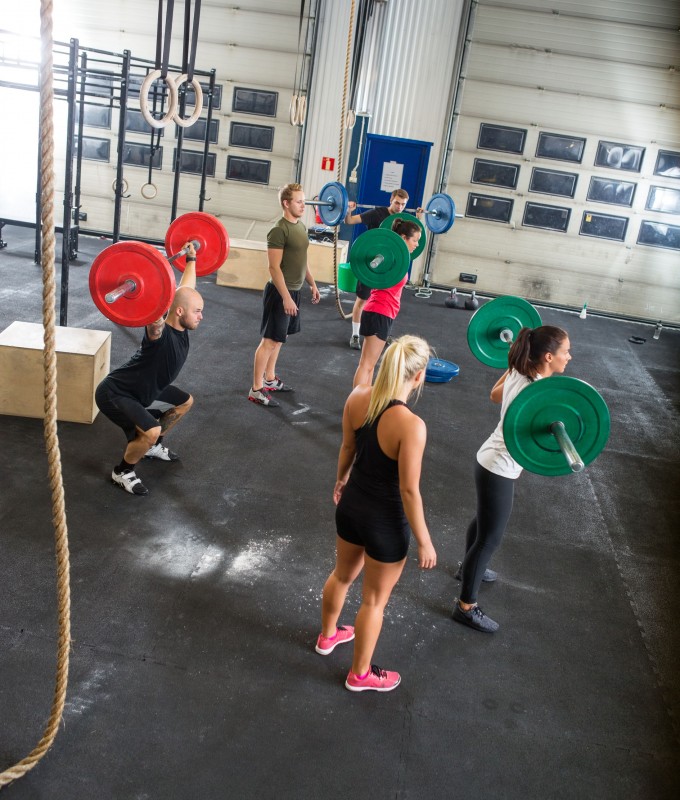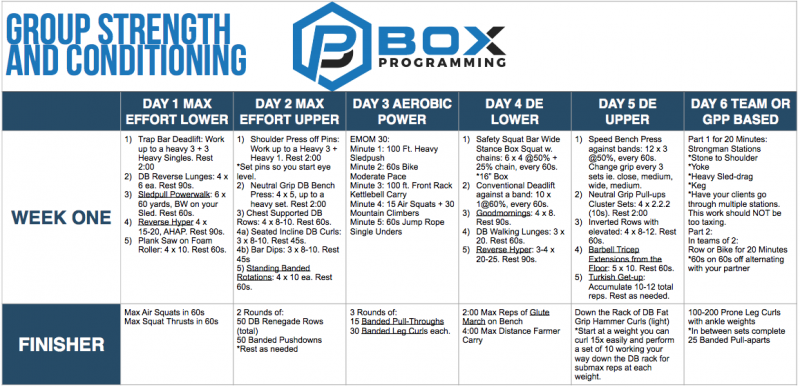
Group fitness has increased exponentially over the last ten years. I can remember when we opened our box in 2011, and there weren’t very many boxes in close proximity to us. Now you can find multiple boxes within walking distance of each other. Additionally, there are more and more strength and conditioning facilities now offering group fitness as an efficient model of delivering fitness to clients that have rather basic goals such as improving body composition and strength.
Box Programming has paved the way for functional fitness in a group setting, but what about the strength and conditioning facilities that now offer group fitness but are not necessarily CrossFit affiliates? Luckily, there is a system that will work incredibly well for their clients too. If you missed “Conjugate Programming for The General Population” I’d recommend you read that first, as you’ll be able to clearly see the differences between our system in boxes and strength and conditioning facilities.
RECENT: Developing Strength and Conditioning in the Same Training Session
The major pushback we receive with our programming that we provide to boxes all over the world is with things like accessory and low-intensity work, which are non-negotiable aspects of our system. The common misconception that you have to be lying on the ground lifeless after each training session is incredibly flawed. So when athletes don’t receive this stimulus daily, they start to ask questions. This is pushback I’m okay with, though, because I know long-term success can only be achieved with some semblance of structure and oversight of how much intensity we deliver to our athletes. More importantly, it’s crucial that the general population receives things like single-joint work and low-intensity training, as these are vital parts of the journey to their goals.
High Intensity or High Burnout?
One of the major drawbacks of box programming—other than high rep Olympic lifting and kipping pull-ups—is the dose and frequency of high-intensity work. Because of the consistent doses of high-intensity conditioning, the shelf life of most box programming athletes is not nearly as long as it could be. We live in a world that is chronically stressed out. People have shitty diets, sleep schedules, and jobs. Add high intensity to the mix, all the time, and you have a perfect storm for overtraining.
For myself, I incurred the ups and downs of high-intensity training from 2006 to 2011, which is when I said to myself that there must be a more sustainable way to do this. Training is a huge part of my life, and when I lost the motivation to train, I knew something was off. This invariably happens when my intensity is too high, too often. The same holds true for many other regular folks.
Let’s be clear, though: we are not debating the efficacy of high-intensity work. Quite the contrary. What we are debating is the delivery of this work to regular folks that have shitty diets, jobs, and sleep patterns. With these cases, there must be a balance of modalities. In a group setting we don’t have the luxury of having as much detail as when training a client one-on-one, so having a systematic template is imperative to their success and, more importantly, their longevity.
The Conjugate Method for Group Fitness
We are going to fully delve into what I feel is the best system available: the conjugate method. This system is particularly effective in a group setting where most clients' goals stem from body composition, with performance goals manifesting themselves organically after we expose our clients to things like compound movements and testing pieces. Unbeknownst to many, the conjugate method is a system of concurrent fitness that works for athletes with a wide range of goals. Whether it be to feel better, move more weight, or run a marathon, the system has something for everyone, which makes it the preferred choice for group programming. It's a no-brainer.
Image credit: Tyler Olson © 123RF.com
Advantages of Conjugate Method for Group Fitness
There are a number of aspects of the conjugate method that make it great for group fitness. Advantages include:
- Well-rounded template that is predictable
- 72 hours of recovery between the more extreme training sessions
- Focus on one's limiting factors
- Building the client's base via low skill general physical preparedness (GPP) work
- Improves all three energy systems concurrently
- Improves body composition
- Improves maximal strength
- Improves power development
- Less chance of boredom with constant variation
- Less chance of overtraining because of variation and balance of intensity and volume.
- Scalable to athletes of all levels
In addition, I’d argue this method works even better for strength and conditioning facilities than it does boxes, because at a box people expect to do things like kipping pull-ups and high rep Olympic lifting. These are things that will not be a part of the programming at a strength and conditioning facility. In addition, we have the ability to have a single focus each training session, which is a much more effective way to train overall.
I was going to make a list of disadvantages just to be objective, but I could only come up with three, some of which could easily be seen as advantages. First, the program favors the most committed. I think it’s safe to say that’s a disadvantage of any program, wouldn’t you? The second is that the template is predictable, but I’ve also seen this viewed as an advantage. Many of your clients already live in a world of unpredictability, so having something they can rely on is helpful. The third disadvantage is that eventually your clients may want to include more conditioning. The good news is that this is very easy to do with this template because the intent of each session is clear.
Box Programming Versus Strength and Conditioning Facility Group Programming
You’re probably wondering what the difference is. The honest answer is not a whole lot. The template looks very similar, but we are going to fully outline how our programming would look in a strength and conditioning facility.
The Template
Monday
- Max Effort Lower Body Movement (Low Volume/High Intensity)
- Sled Work and Special Exercise Work
- “Finisher”
Tuesday
- Max Effort Upper Variation (Low Volume/High Intensity)
- Special Exercise Work
- “Finisher”
Wednesday
- Long Duration Aerobic Power Work or GPP Work
- High Volume Band Work
Thursday
- Dynamic Effort Lower Body (Moderate to High Volume/Moderate Intensity)
- Special Exercise Work
- “Finisher”
Friday
- Dynamic Effort Upper Body (Moderate to High Volume/Moderate Intensity)
- Special Exercise Work
- High Volume Band Work
Saturday
This session is geared at being fun and changing things up each week.
- Team Training or Strongman Events
- Special Exercise Work
Sunday
Choose from:
- Off Day
- Open Gym
- Zone 1 Cyclical Work
- Other Active Recovery Measures
The major differences are that on max effort or dynamic effort days, we are able to deliver a full session of training with a single focus. This is not the case at a box, where more times than not there is energy system work included. For most, these sessions will be quite challenging even though there is no set conditioning work for these days. The volume of our special exercise work is high, as exercises are low demand. The pace at which we complete this work is fast, so your clients will likely still be pretty winded.
Our training sessions between max effort and dynamic effort training are intended to be aerobic-based, for a number of reasons. First off, we want to ensure our clients are working on improving their aerobic capacity, which will directly translate to other areas of their fitness. Second, we have to be mindful of the fact that more than a few of our clients probably don’t have ideal eating and sleep patterns, as well as having stressful jobs. If we only pile on high intensity work, we set them up for failure and inevitable burnout. Third, we can effectively facilitate recovery between our more extreme training sessions. Overall, these sessions are paramount to ensure we don’t burn out our clients. Finally, in order for our clients to improve their work capacity, we need to improve their aerobic capacity to be able to tolerate higher volumes of work down the road.
Sample Week of Programming
In short, the conjugate method is hands down the most effective system I’ve ever used for clients in a group setting, particularly in terms of longevity and consistent progression. My goal is to be able is to train consistently for the rest of my life on this earth. Our goals for our clients should be no different. We are helping people improve their lives and live longer; running our clients into the ground daily makes zero sense and will not lend itself to their longevity at your facility.
Remember, any coach can prescribe a hard workout that leaves their clients gasping for air on the floor. A great coach will know when and how to prescribe the correct doses of training that will allow their clients to make progress and train at their facility for a lifetime.
Group S&C Sample Week
Header Image Credit: langstrup © 123rf.com












